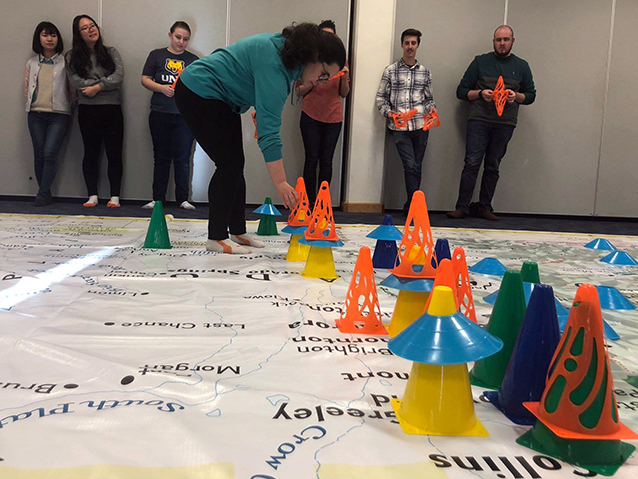Using Giant Maps
Logistics
Here are some documents that might help you use your Giant Map.
- Giant Map Background and Information
- Giant Map Inventory
- Giant Map Materials List
- Giant Map Folding Instructions
- 2018 Locations Hosting Giant Map
Please note these materials were produced in 2018 by the Colorado Geographic Alliance and may be out of date.
What to Expect
Selecting a space
The map is vinyl and folded for travel. It can fit a space slightly larger than 14 x 21 feet if there are no desks or other objects in the classroom. Having enough space for students to sit around the map is preferred, so a library or a gymnasium is a great spot. The space should be flat and can be carpeted or wood. The floor should be vacuumed or swept prior to the arrival of the map. It does not take long to set up once the space is prepared.
Using the map
Instructions and materials are included with the map. Check out the video below from National Geographic of the map in use.

Teaching Secondary Social Studies students at UNC learning to use a Colorado Giant Map.
Map Rules
The following are important rules to discuss with students:
- The area should be vacuumed or swept before laying the map down.
- No food or drinks are allowed on the map.
- No writing utensils are allowed on the map.
- Socks are mandatory.
- No sliding or shuffling on the map (this can create scuff marks and tears).
- The map should be swept off before folding.
- The most important rule: have fun and enjoy!
Preparing for the Giant Map lesson
Identify the goal of the Giant Map lesson. Do you want students to become familiar with map reading in general? Are you focusing on teaching Colorado geography, history, environment, and landforms? Depending on the lesson, preparation and follow-up activities can be planned to reinforce the content and skills that the Giant Map will be demonstrating. Students should be reminded to bring socks and to avoid sliding on the Giant Map.
The curriculum for the map is located online. Reviewing the curriculum in advance is a great way to prepare to get the most out of your Giant Map visit. Explore the lessons that might be most appropriate for your classroom. However, you are also welcome to create your own lessons (check out the Lessons and Materials page for more information).

